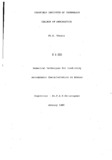JavaScript is disabled for your browser. Some features of this site may not work without it.
| dc.contributor.advisor | Christopher, P. A. T. | |
| dc.contributor.author | Deo, H. S. | |
| dc.date.accessioned | 2023-01-19T13:56:02Z | |
| dc.date.available | 2023-01-19T13:56:02Z | |
| dc.date.issued | 1986-01 | |
| dc.identifier.uri | https://dspace.lib.cranfield.ac.uk/handle/1826/18996 | |
| dc.description.abstract | Two methods are presented characteristics of bodies SUMMARY for predicting the aerodynamic in inviscid and irrotational flow. The first method is limited to incompressible flow and makes use of panels of ring sources to approximate the body surface. The technique is dedicated to single, axisymmetric body configurations in either uniform longitudinal or rectilinear motion. The versatility of the method is due to the use of sources as singularities placed on the body surface, allowing discontinuous body profiles to be analysed. The method has been compared for accuracy and efficiency with experimental and theoretical results. Further investigation showed that at present there existed no numerical technique which could predict the aerodynamic behaviour of multiple bodies in compressible flow. Hence, a fully three-dimensional method was developed which made use of the Full Potential Equation (F.P.E.) in conservative form. A computational mesh is placed around the body configuration and at each mesh node the F.P.E. is satisfied ~n finite difference form. The method is able to give a complete description of the flow around the bodies at transonic mach numbers. Comparisons to test the accuracy and efficiency of the method are limited to either, purely subsonic flow for two body configurations or zero incidence for transonic flow around a single body. | en_UK |
| dc.language.iso | en | en_UK |
| dc.title | Numerical techniques for predicting aerodynamic characteristics of bodies | en_UK |
| dc.type | Thesis | en_UK |
| dc.description.coursename | PhD | en_UK |
